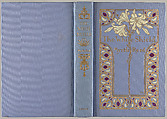The white shield
Not on view
"The White Shield, a collection of short sketches by Myrtle Reed. New York: G.P. Putnam's Sons (The Knickerbocker Press), 1912. First Putnam Edition. 8vo. xi, 343 pp., With 5 unnumbered leaves of black and white plates, by Dalton Stevens (see below), including a full-color frontispiece; headlines in red throughout, music type featured in "Swing Low, Sweet Chariot." With publisher's advertisement for other books by Reed laid in. Bound in original publisher's lavender cloth, stamped with gold, maroon, and gilt: central floral design with cream flower petals, floral style border around central design, signed "MA" (Margaret Armstrong) in bottom corner, gilt lettering on spine with two bordering fleuron-type ornaments, also gilt, head and foot of spine almost imperceptively bumped, lower cover with 1cm blemish. Top edge gilt, other edges rough cut as issued, Ownership inscription of Rosamond Berry on front endleaf. Preserved in glassine jacket. Very nice binding designed by famed book decorator Margaret Armstrong, during the "golden age" of American Art Nouveau publisher's bindings. This Putnam edition features the first appearance of her design. Margaret Armstrong (1867-1944) flourished in designing book covers and decorating texts from 1890-1926. With a background in painting, she began designing book covers with the McClurg Publishing Company, though quickly began freelancing her work to a variety of publishers, including Scribner and G.P. Putnam, her two most important clients. Her bindings are generally identifiable through the monogram "MA" with which she signs them, as here. Armstrong favored abstract and floral designs, much like her possible model, fellow designer Sarah Wyman Whitman, though with a wide color palette and little empty space on her covers, often repeating the same design style for a particular author. Thus, the bindings she designed for Myrtle Reed's books are fairly similar in style and aesthetic, though her later designs show the influence of the then-new Art Nouveau style, complete with stylized plants and asymmetrical designs, such as here. Armstrong, along with Whitman and Alice Cordelia Morse (1863-1961), is considered to be one of the best book designers of the "golden age" of publisher's bindings, helping to pave the way for women artists to gain professional status and bring good design to mass production. Myrtle Reed (1874-1911) followed in her mother's footsteps and became an accomplished author, with several bestselling novels and cookbooks, the latter of which she published under the pseudonym Olive Green. The stories in "The White Shield," consisting of mostly reprintings of her periodical work, was first published by Grosset & Dunlap in 1902. Our edition was published posthumously, as Reed overdosed on sleeping powder with suicidal intent in 1911." -- Michael Laird.
Photographs of binding from Watson Library Digital Collections https://libmma.contentdm.oclc.org/digital/collection/p16028coll17/id/4921
Due to rights restrictions, this image cannot be enlarged, viewed at full screen, or downloaded.
This artwork is meant to be viewed from right to left. Scroll left to view more.



